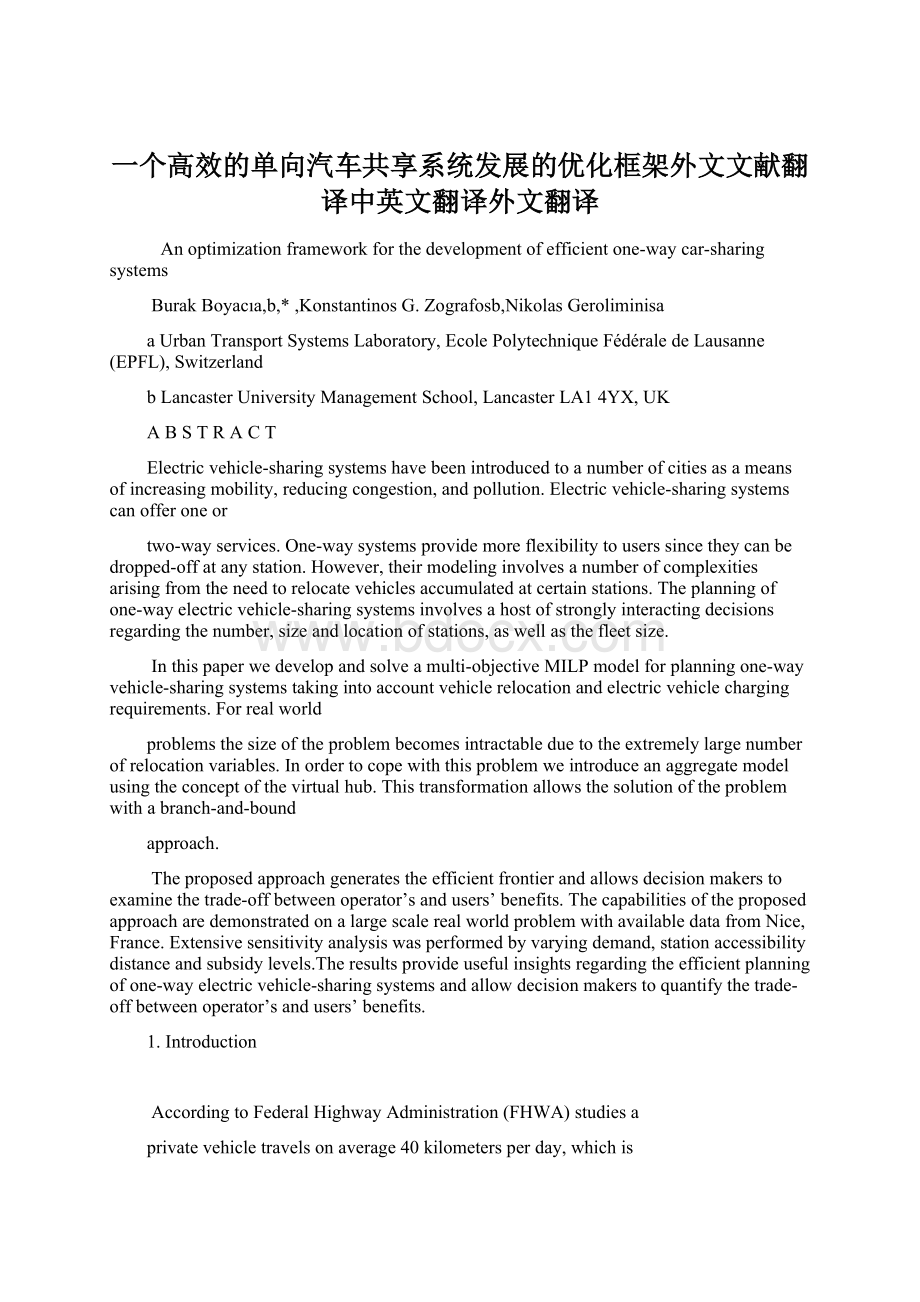一个高效的单向汽车共享系统发展的优化框架外文文献翻译中英文翻译外文翻译Word文件下载.docx
《一个高效的单向汽车共享系统发展的优化框架外文文献翻译中英文翻译外文翻译Word文件下载.docx》由会员分享,可在线阅读,更多相关《一个高效的单向汽车共享系统发展的优化框架外文文献翻译中英文翻译外文翻译Word文件下载.docx(32页珍藏版)》请在冰豆网上搜索。

two-wayservices.One-waysystemsprovidemoreflexibilitytouserssincetheycanbedropped-offatanystation.However,theirmodelinginvolvesanumberofcomplexitiesarisingfromtheneedtorelocatevehiclesaccumulatedatcertainstations.Theplanningofone-wayelectricvehicle-sharingsystemsinvolvesahostofstronglyinteractingdecisionsregardingthenumber,sizeandlocationofstations,aswellasthefleetsize.
Inthispaperwedevelopandsolveamulti-objectiveMILPmodelforplanningone-wayvehicle-sharingsystemstakingintoaccountvehiclerelocationandelectricvehiclechargingrequirements.Forrealworld
problemsthesizeoftheproblembecomesintractableduetotheextremelylargenumberofrelocationvariables.Inordertocopewiththisproblemweintroduceanaggregatemodelusingtheconceptofthevirtualhub.Thistransformationallowsthesolutionoftheproblemwithabranch-and-bound
approach.
Theproposedapproachgeneratestheefficientfrontierandallowsdecisionmakerstoexaminethetrade-offbetweenoperator’sandusers’benefits.ThecapabilitiesoftheproposedapproacharedemonstratedonalargescalerealworldproblemwithavailabledatafromNice,France.Extensivesensitivityanalysiswasperformedbyvaryingdemand,stationaccessibilitydistanceandsubsidylevels.Theresultsprovideusefulinsightsregardingtheefficientplanningofone-wayelectricvehicle-sharingsystemsandallowdecisionmakerstoquantifythetrade-offbetweenoperator’sandusers’benefits.
1.Introduction
AccordingtoFederalHighwayAdministration(FHWA)studiesa
privatevehicletravelsonaverage40kilometersperday,whichis
approximately90minutestime.Fortherestofthetimethisvehicleisidleandoccupiesaparkingspot(FHWA,2010).Analternative
iscar-sharing(alsoknownasshared-usevehicle)systems,which
haveattractedconsiderableattentionwithmultipleimplementationsworldwideduetotheirpotentialtoimprovemobilityandsustainability(Shaheen&
Cohen,2013).Thesesystemsprovidebenefitsbothtotheirusersandthesocietyasawhole.Reducedpersonaltransportationcostandmobilityenhancementhavebeencitedasthetwomostnotablebenefitstoindividualusers.Recentstudiesshowthat,car-sharingalsodecreasesaveragevehiclekilometerstraveledand,itislikelytodecreasecongestion(Crane,Ecola,Hassell,&
Natarah,2012)andemissions(Shaheen
&
Cohen,2013).Provisionofaffordablemobilitytoeconomically
disadvantagedgroupswithon-demandandpublictransportationsystemsisanothersocietalbenefit(Duncan,2011).
Theattractivenessofcar-sharingsystemsisdeterminedbythe
levelofserviceofferedandthecostassociatedwiththeuseofthe
system.Thelevelofserviceisinfluencedbytheaccessibilityof
vehiclestationsbythepotentialusers,i.e.(i)thedistancebetween
user’soriginanddestinationfrompick-upanddrop-offvehicle
stationsrespectively,and(ii)theavailabilityofvehiclesatstations.
Ontheotherhand,stationnumberandsize,aswellasfleetsize
andavailabilityofvehicles,atthe‘‘righttime’’atthe‘‘rightstation’’,influencethecostofestablishingandoperatingacar-sharing
System.Thecar-sharingsystemscanbeclassifiedintoflexible‘‘one-
way’’andthemorerestricted‘‘two-way’’types,accordingto
whethertheusersshouldreturntherentedvehicleatadifferentor
atthelocationtheypickeditup.The‘‘one-way’’systemsarealso
classifiedas‘‘free-floating’’and‘‘non-floating’’accordingtoparkingspotrestrictions.Theformerreferstoasystemwithout
restrictedparkingspots.Userscanpick-upordrop-offvehiclesin
anyparkingspotrestrictedwithinthebordersofanarea.Thelatter
isusedfordefiningsystemsinwhichpick-upanddrop-offlocationsofthevehiclesshouldbedesignatedparkingspots.‘‘free-floating’’models,reservationisnotpossiblewhereas‘‘non-floating’’modelsprovideusersboththeabilitytomakereservationandtheflexibilityofone-waytrips.Whiletwo-waysystemsallowusersforreservations,thestateofpracticeinone-waysystemsisrenting-basedonreal-timeavailabilityorwithshorttermreservations(e.g.30minutesinadvance).Arecent
studyshowedwithanagentbasedsimulationthatparkingreservationscanimprovethequalityofserviceforone-waycarsharingsystems(Kaspi,Raviv,&
Tzur,2014).
Theproblemofensuringvehicleavailabilityandfulfillingreser-
vationbecomesmoreprominentwhenthevehiclescanberented
andusedonaone-waybasisinnon-floatingsystems.Theone-wayoperationofthevehiclescoupledwiththeimbalanceofdemandforvehicles,bothattheoriginofthetrip(pick-upstation)andatthedestination(drop-offstation),mayresulttoasituationwherevehiclesareaccumulatedtostationswheretheyarenotneeded,whileatthesametimethereisvehicleshortageatthestationswheremorevehiclesareneeded(Barth,Todd,&
Xue,2004).
Vehiclerelocation,i.e.transferofvehiclesfromstationswith
highvehicleaccumulationtostationswhereshortageisexperienced,isatechniquethathasbeenproposedtoimprovetheperformanceofone-waycar-sharingsystems(e.g.Cucu,Ion-Boussier,Ducq,&
Boussier,2009;
Jorge,Correia,&
Barnhart,2014;
Kek,Cheu,&
Chor,2006).Thelackofefficientvehiclerelocationcoupledwiththeneedtoguaranteeagivenlevelofvehicleavailabilitymayleadtoanunnecessaryincreaseofthefleetsizeandvehicleunderutilization.Theefficientandcost-effectivestrategicplanning,andtheoperationofone-waycar-sharingsystemsrequiremodelsthatwilloptimallydeterminethenumberandlocationoftheservicestations,thefleetsize,andthedynamicallocationofvehiclestostations.Thesemodelsshouldassistdecisionmakerstostrikeanoptimumbalancebetweenthelevelofserviceofferedandthetotalcost(includingvehiclerelocationcosts)forimplementingandoperatingthecar-sharingsystem.
However,theliteraturecurrentlylacksamodelthatcan
considersimultaneouslydecisionsrelatedtothedeterminationof
stationlocation,sizeandnumber,andfleetsize,whiletakinginto
accountthedynamicsofvehiclerelocationandbalancingforasystemwithreservations.Existingmodels(Correia&
Antunes,2012;
Lin&
Yang,2011)eitherlookatstationlocationswithoutdueconsiderationtovehiclerelocationdecisions(Lin&
Yang,2011),orconsiderstationlocationsassumingthatonlythedemandinthecatchmentareaofopenedstationsneedstobeserved(Correia&
Antunes,2012).Inthecasewherevehiclerelocationismodeled(Correia&
Antunes,2012),therelocationofthevehiclesandtheassociatedcostsareconsideredonlyattheendoftheoperatingperiod(usuallyaday),andthereforetheyareinfluencingthefleetsize.
Theobjectiveofthispaperistwofold:
(i)todevelopandsolvea
mathematicalmodelfordeterminingtheoptimumfleetsize,and
thenumberandlocationoftherequiredstationsofone-way
non-floatingreservation-based,forbothpick-upanddrop-off,
car-sharingsystemsbytakingintoaccountthedynamicrepositioning(relocation)ofvehicles,and(ii)toapplytheproposedmodelforplanningandoperatingaone-wayelectricalcar-sharingsysteminthecityofNice,France.
Theremainderofthispaperisorganizedasfollows.Section2
providesanoverviewofpreviousrelatedworkandfurtherelaboratesontheargumentsjustifyingtheneedfortheproposedmodel,Section3presentstheformulationandthesolutionapproachoftheproposedmodel,Section4describestheapplicationoftheproposedmodelforplanningandoperatingaone-wayelectricalcar-sharingsysteminNice,France,Section5highlightspracticalconsiderationswhileSection6discussestheresearchconclusionsandprovidesrecommendationsforfuture
Research.
2.Previousrelatedresearch
Modelsrelatedtotheplanningandoperationofcar-sharing
systemscanbeclassifiedintothefollowingtwobroadcategories:
(i)modelsaddressingstrategicplanningdecisionsand(ii)models
supportingoperationaldecisions.
2.1.Modelsforstrategicplanningdecisions
Strategicplanningdecisionsseektodeterminethenumber,size
andlocationofstations,andthenumberofthevehiclesthatshould
beassignedtoeachstation,inordertooptimizeameasureoracombinationofmeasuresforsystemperformance.Stationlocationmodelshavebeendevelopedtolocatebicyclestations(Lin&
Yang,2011)andcarstations(Correia&
Antunes,2012).Althoughthefocusofourworkisonelectricalcar-sharingsystems,wealsoreviewmodelsthataddressthestationlocationofshared-usebicycles,givensomesimilaritiesofthetwosystems.
Theproblemoflocatingstationsforshared-usebicycleshas
beenstudiedrecently(Lin&
Yang,2011).Thispaperpresentsa
modelfordeterminingthenumberandlocationofbicyclestations
andthestructureofthenetworkofbicyclepathsthatshouldbe
developedtoconnectthebicyclestations.Theproblemisformulatedasanon-linearintegermodel.Theobjectivefunctionusedexpressesthetotalyearlycostencounteredbytheoperatorandtheusers.Asmallscaleexamplewasusedtoillustratethe